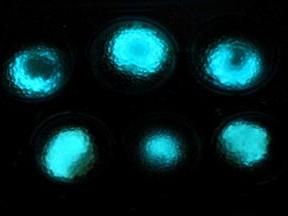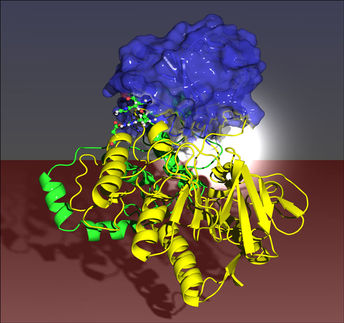Glowing bacteria detect buried landmines
The need for safe and efficient technologies for detecting buried landmines and unexploded ordnance is a humanitarian issue of immense global proportions. About half a million people around the world are suffering from mine-inflicted injuries, and each year an additional 15 to 20 thousand more people are injured or killed by these devices. More than 100 million such devices are still buried in over 70 countries.

These luminous microbial beads demonstrate the fluorescent signal produced by the bacteria
Hebrew University
The major technical challenge in clearing minefields is detecting the mines. The technologies used today are not much different from those used in World War II, requiring detection teams to risk life and limb by physically entering the minefields. Clearly, there is a critical need for an efficient solution for the remote detection of buried landmines and unexploded ordnance.
Researchers from the Hebrew University of Jerusalem now report a potential answer to this need. They present a novel, functional system combining lasers and bacteria to remotely map the location of buried landmines and unexploded ordnance.
The system is based on the observation that all landmines leak minute quantities of explosive vapors, which accumulate in the soil above them and serve as markers for their presence. The researchers molecularly engineered live bacteria that emit a fluorescent signal when they come into contact with these vapors. This signal can be recorded and quantified from a remote location.
The bacteria were encapsulated in small polymeric beads, which were scattered across the surface of a test field in which real antipersonnel landmines were buried. Using a laser-based scanning system, the test field was remotely scanned and the location of the buried landmines was determined. This appear to be the first demonstration of a functional standoff landmine detection system.
"Our field data show that engineered biosensors may be useful in a landmine detection system. For this to be possible, several challenges need to be overcome, such as enhancing the sensitivity and stability of the sensor bacteria, improving scanning speeds to cover large areas, and making the scanning apparatus more compact so it can be used on board a light unmanned aircraft or drone," said Prof. Shimshon Belkin, from the Hebrew University's Alexander Silberman Institute of Life Sciences, who was responsible for genetically engineering the bacterial sensors.
Original publication
Original publication
Shimshon Belkin, Sharon Yagur-Kroll, Yossef Kabessa, Victor Korouma, Tali Septon, Yonatan Anati, Cheinat Zohar-Perez, Zahi Rabinovitz, Amos Nussinovitch & Aharon J Agranat; "Remote detection of buried landmines using a bacterial sensor"; Nature Biotechnology; 2017
Topics
Organizations
Other news from the department science
These products might interest you

Octet R2 / Octet R4 / Octet R8 by Sartorius
Full power on 2, 4 or 8 channels: Label-free and GxP-compliant analysis of molecular interactions
Innovative label-free real-time protein quantification, binding kinetics and rapid screenings

Octet SF3 by Sartorius
Surface Plasmon Resonance (SPR) using Single Dynamic Injections for Kinetics and Affinities
Curvature is Key - Adding a ‘Third Dimension’ to the Binding Curve

Octet RH16 and RH96 by Sartorius
Efficient protein analysis for process optimisation and manufacturing control in high-throughput
Label-free protein quantification and characterization of protein-protein interactions

Get the life science industry in your inbox
By submitting this form you agree that LUMITOS AG will send you the newsletter(s) selected above by email. Your data will not be passed on to third parties. Your data will be stored and processed in accordance with our data protection regulations. LUMITOS may contact you by email for the purpose of advertising or market and opinion surveys. You can revoke your consent at any time without giving reasons to LUMITOS AG, Ernst-Augustin-Str. 2, 12489 Berlin, Germany or by e-mail at revoke@lumitos.com with effect for the future. In addition, each email contains a link to unsubscribe from the corresponding newsletter.




















































